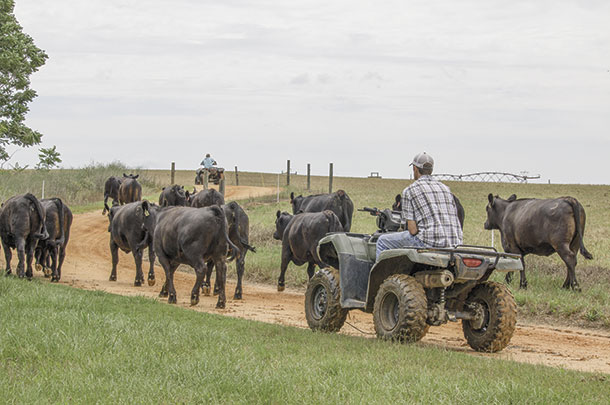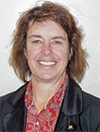Many ranches today utilize ATVs for jobs that historically were done on horseback, and some beef operations do not even own a horse. There are some distinct differences between an ATV and a horse. One of the most obvious differences is noise level. Horses are quiet while an ATV has a constant engine noise. Both have horns. The ATV horn makes noise, and a saddle horn you can dally to when doctoring cattle. Both have brakes controlled by the rider’s hands. On an ATV, you use two eyes to see what is going on and where you are traveling. On a horse, there are four eyes: yours and the horse’s.
An ATV needs more room to turn than a horse does. When riding an ATV, the relationship is animal to machine, while horseback it is animal to animal. From the rider’s perspective, when on an ATV, the rider is on the same level as the cow. When horseback, the rider is above the cow. Most importantly, speed must be considered. A horse’s speed at a walk is close to the same speed as a cow.
An ATV can move at an idle faster than a cow can walk. When working or sorting cattle with a horse, you turn toward the cattle so you can continue to see them. With an ATV, it may be necessary to turn away from the cattle so as not to apply too much pressure.
When making the decision to gas up the ATV or saddle the horse, there are several things to consider.
- What is the job that needs to be accomplished? If the goal is to check on the cattle, do some irrigation and check fences, choose your favorite or most efficient “ride.” If the job is to doctor something in the pasture, you probably want a good horse with a saddle horn you can dally to. If the goal is to work cattle in the corral, on foot or horseback would be a better choice since it is a tighter area.
- What is the terrain like? When deciding which to ride, consider the terrain. Horses can jump ditches or wade through. ATVs sometimes needs a bridge or culvert if the ditch is deep or has steep banks. Rolling hills are good ATV terrain, but rockslides, steep hills and cattle/deer trails are more horse-friendly.
- What is the plant community? ATVs can have a larger impact on plants and grasses than a horse. A “one-time” ride-over with an ATV and the plants will recover quickly, but repeated trips will have a detrimental effect. Consider if you will be riding through sensitive areas where soil compaction by an ATV could be an issue. Repeated trips can cause new “trails” and less forage. When needing to move cattle through forested areas or willows, there may not be enough room for an ATV.
 An ATV provides convenience, speed and closer proximity to cattle. Staff photo.
An ATV provides convenience, speed and closer proximity to cattle. Staff photo.Stockmanship is defined as “knowledgeable and skillful handling of livestock.” Good stockmanship is safe, efficient and effective. It should be low-stress. Stockmanship considers natural cattle behavior, how a cow sees, her point of balance and flight zone.
Being a prey species, cattle want to see you. They also want to go around you when you are moving through them. They are a herd animal, so being separated from others is high-stress for them. Cattle do not like pressure. They will want to go to the last known safe place when pressured. They are simple animals and can only process one main thought at a time.
Cattle have a wide angle of vision due to the location of their eyes. The full range of vision is 270 degrees with a blind spot directly behind them. Directly in front of them, they have binocular vision, and off to each side they have panoramic vision. A cow’s point of balance is at the shoulder. When moving them, remember: If you are behind the point of balance, they will move forward. If you are in front of that point, they will move backward or turn away.
Not all cows have the same size flight zone. A flight zone is a “cow’s personal space.” As you are moving toward the cow, she will start to move once you have entered her flight zone. The area outside the flight zone is the pressure zone. The pressure zone is where you should work cattle. A cow’s flight zone may be different-sized depending on if you are approaching them on foot, horse or ATV. All this needs to be considered when moving cattle, regardless whether you are riding an ATV, a horse or on foot.
It takes time and effort to get your cattle accustomed to being moved with an ATV. When first starting, let the cattle get close to it, smell it and be around it when it is turned off. Drive it through and around the cattle when you do not have to accomplish anything. For some reason, when moving cattle on an ATV, good stockmanship tends to go out the window, and the rider thinks they are invincible. There are numerous videos on the internet showing riders ramming cows with an ATV. This is not good stockmanship and not a good representation of the industry. It is only an excellent example of how easy it is to apply too much pressure when moving cattle with an ATV.
This is also not a safe situation for the rider. The rider is at the same level as the cow, so they are fully exposed to the cow if she was to turn around and fight back. The problem here is not the ATV, but the rider.
So when heading out and deciding whether to ride your ATV or horse, think about what needs to be accomplished. Is the situation based in the corral, or is it out in the big pasture or on the range? Consider the terrain that will be ridden through and the plant communities on that terrain. After careful consideration, choose your “ride” and always practice good stockmanship.








